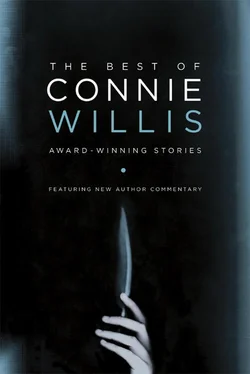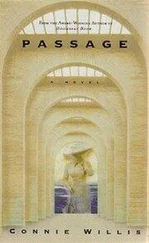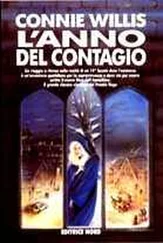But I didn’t smell it. I wandered up and down the passages of the Central and Northern and District Lines, stood on each of the platforms, waited in the corners near the stairways for over an hour, and nothing.
It doesn’t happen all the time, I thought, taking the Circle Line to Liverpool Street. There’s some other factor—the time of day or the temperature or the weather. Maybe the winds only blew when London was experiencing an inversion layer. I should have checked the weather this morning, I thought.
Whatever the factor was, there was nothing at Liverpool Street, either, but at Euston the wind hit me full force the minute I stepped off the train—a violent blast of soot and dread and charred wood. Even though I knew what it was now, I had to lean against the cold tiled wall a moment till my heart stopped pounding and the dry taste of fear in my mouth subsided.
I waited for the next train and the next, but the wind didn’t repeat itself, and I went down to the Victoria Line, thought a minute, and went back up to the surface to ask the ticket seller if the tracks at Bounds Green were aboveground.
“I believe they are, sir,” he said in a thick Scottish brogue.
“What about Balham?”
He looked alarmed. “Balham’s the other way. It’s not on the same line, either.”
“I know,” I said. “Are they? Aboveground?”
He shook his head. “I’m afraid I don’t know, sir. Sorry. If you’re going to Balham, you go down to the Northern Line and take the train to Tooting Bec and Morden. Not the one to Elephant and Castle.”
I nodded. Balham was even farther out in the suburbs than Bounds Green. The tracks were almost certain to be aboveground, but it was still worth a try.
Balham had taken the worst hit of any of the stations. The bomb had fallen just short of the station, but in the worst possible place. It had plunged the station into darkness, smashed the water and sewer pipes and the gas mains. Filthy water had rushed into the station in torrents, flooding the pitch-black passages, pouring down the stairs and into the tunnels. Three hundred people had drowned. And how could that not still be there, even if Balham was aboveground? And if it was there, the smell of sewage and gas and darkness would be unmistakable.
I didn’t follow the ticket vendor’s directions. I detoured to Blackfriars, since it was nearly on the way, and stood around its yellow-tiled platforms for half an hour with no result before going on to Balham.
The train was nearly deserted for most of the long trip. From London Bridge out there were only two people in my car, a middle-aged woman reading a book and, at the far end, a young girl, crying.
She had spiked hair and a pierced eyebrow, and she cried helplessly, obliviously, making no attempt to wipe her mascaraed cheeks, or even turn her head toward the window.
I wondered if I should go ask her what was wrong or if the woman with the book would think I was hitting on her. I wasn’t even sure she would be aware of me if I did go over—there was a complete absorption to her sorrow that reminded me of Cath, intent on finding her china. I wondered if that was what had broken this girl’s heart, that they had discontinued her pattern? Or had her friends betrayed her, had affairs, gotten old?
“Borough,” the automated voice said, and she seemed to come to herself with a jerk, swiped at her cheeks, grabbed up her knapsack, and got off.
The middle-aged woman stayed on all the way to Balham, never once looking up from her book. When the train pulled in, I went over and stood next to her at the door so I could see what classic of literature she found so fascinating. It was Gone with the Wind .
But the winds aren’t gone, I thought, leaning against the wall of Balham’s platform, listening for the occasional sound of an incoming train, futilely waiting for a blast of sewage and methane and darkness. The winds of the Blitz are still here, endlessly blowing through the tunnels and passages of the Tube like ghosts, wandering reminders of fire and flood and destruction.
If that was what they were. Because there was no smell of filthy water at Balham, or any indication that any had ever been there. The air in the passages was dry and dusty. There wasn’t even a hint of mildew.
And even if there had been, it still wouldn’t explain Holborn. I waited through three more trains on each side and then caught a train for Elephant and Castle and the Imperial War Museum.
“Experience the London Blitz,” the poster had said, but the exhibit didn’t have anything about which tube stations had been hit. Its gift shop yielded three more books, though. I scoured them from cover to cover, but there was no mention at all of Holborn or of any bombings near there.
And if the winds were leftover breezes from the Blitz, why hadn’t I felt them the first time we were here? We had been in the Tube all the time, going to the conference, going to plays, going off on the Old Man’s wild hares, and there hadn’t been even a breath of smoke, of sulfur.
What was different that time? The weather? It had rained nearly nonstop that first time. Could that have affected the inversion layer? Or was it something that had happened since then? Some change in the routing of the trains or the connections between stations?
I walked back to Elephant and Castle in a light rain. A man in a clerical collar and two boys with white surplices over their arms were coming out of the station. There must be a church nearby, I thought, and realized that could be the solution for Holborn.
The crypts of churches had been used as shelters during the Blitz. Maybe they had also been used as temporary morgues.
I looked up “morgue” and then, when that didn’t work, “body disposal.”
I was right. They had used churches, warehouses, even swimming pools after some of the worst air raids to store bodies.
I doubted if there were any swimming pools near Holborn, but there might be a church.
There was only one way to find out—go back to Holborn and look. I looked at my tube map. Good. I could catch a train straight to Holborn from here. I went down to the Bakerloo Line and got on a northbound train. It was nearly as empty as the one I’d come out on, but when the doors opened at Waterloo, a huge crowd of people surged onto the train.
It can’t be rush hour yet, I thought, and glanced at my watch. Six-fifteen. Good God. I was supposed to meet Cath at the theater at seven. And I was how many stops from the theater?
I pulled out my tube map and clung to the overhead pole, trying to count. Embankment and then Charing Cross and Piccadilly Circus. Five minutes each, and another five to get out of the station in this crush. I’d make it. Barely.
“Service on the Bakerloo Line has been disrupted from Embankment north,” the automated voice said as we pulled in. “Please seek alternate routes.”
Not now! I thought, grabbing for my map. Alternate routes.
I could take the Northern Line to Leicester Square and then change for Piccadilly Circus. No, it would be faster to get off at Leicester Square and run the extra blocks.
I raced off the train the minute the doors opened and down the corridor to the Northern Line. Five to seven, and I was still two stops away from Leicester Square, and four blocks from the theater. A train was coming in. I could hear its rumble down the corridor. I darted around people, shouting, “Sorry, sorry, sorry,” and burst onto the packed northbound platform.
The train must have been on the southbound tracks. NEXT TRAIN 4 MIN., the overhead sign said.
Great, I thought, hearing it start up, pushing the air in front of it, creating a vacuum in its wake. Embankment had been hit. And that was all I needed right now, a blast from the Blitz.
Читать дальше












